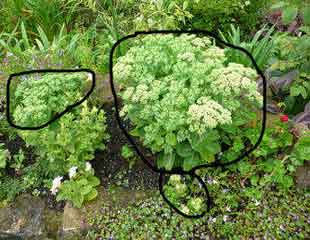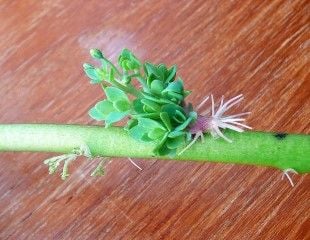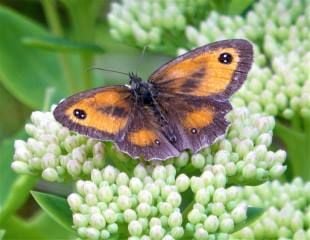
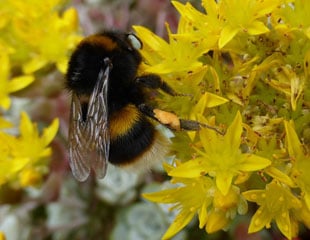
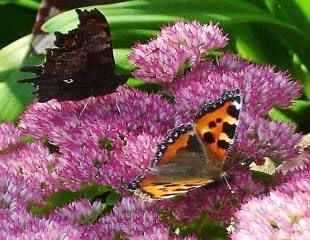
How to Grow Sedum
Sedums, common name stone crop, are a wide-ranging genus of about 400 species with a variety of flowering colours and times. The Sedum illustrated (above right) is Ruby Glow, a popular and commonly grown variety which produces spectacular red flowers from late summer into early autumn. Sedums vary in size, some are low growing and suitable for a rock garden, (middle image) and others such as Ruby Glow and autumn flowering species are around the 25cms in height suitable for the front of a mixed border.
I love Sedums, they have so much going for them. Sedum look great when they are emerging with fresh strong green waxy foliage, beautiful just as the buds are emerging, and when fully in flower. The seed heads look good over winter when dusted with frost.
In the Summer they attract dozens of pollinators, bees and butterflies as soon as the flower heads form and they are easy to propagate. On this page are many images of Sedum. They are one of my top ten plants. All very easy to grow, requiring no attention once planted. I cannot imagine having a garden without planting sedums in it.
Sedums are best planted where they will enjoy good sun with soil that is not too dry. Sedums will grow in partial shade, but not full shade. Sedum is a very undemanding plant and is virtually maintenance free apart from a trim back in the spring.
And just to be botanically correct, those clever scientists have re named Sedums as Hylotelphium. It's all to do with DNA apparently, but I think we will be calling them Sedums for a long time.
Sedums for bees and butterflies
A major advantage of Sedums is as a top 10 plants for attracting bees, hover flies and butterflies, especially when they first flower and are full of nectar. It is not unusual to spot several butterflies, a mass of bees and hover flies all together on a single Sedum plant on a warm day. Sedums earn their reputation as the butterfly's friend, as they truly attract butterflies like a magnet. A good place to plant Sedum is near a garden seat where you can relax watching the bees and butterflies feeding on the Sedums.
Just to illustrate the point, this is a short 2min 30 video showing the Sedums with a cloud of butterflies, bees and pollinators.
Suttons have a wide range of Sedums including Sedum spectabile 'Brilliant' whose pink flowers have a high level of nectar making it super attractive to butterflies.
When to cut back Sedums
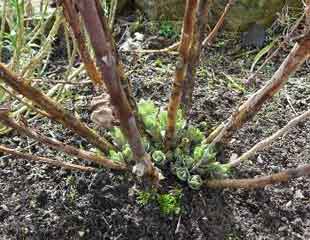
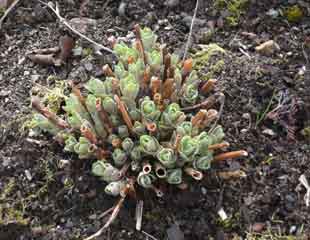
It is best not to dead head the plants as they look fantastic with snow and ice on them, see images below. In the spring the new growth is easily visible at the root as in the image above left, which indicates that is the time to cut the Sedum back, as in the image above right. The first image, left, has the old stems still in place, in the second image the growth has been cut away ready for the spring.
Image of Sedum just coming into flower
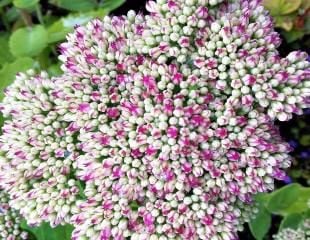
Sedums look really attractive from the very start of their flowering period. This image shows a Sedum just starting to flower. The exact timing depends very much on the summer weather, anything from the 3rd week of August onwards
Sedum with frost
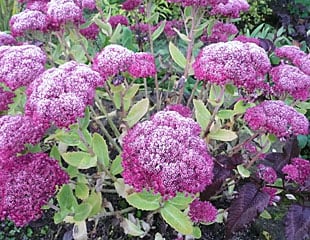
Overwinter, I leave if the flower heads in place, the frost looks attractive on the flower heads and livens up the winter borders.
Types of Sedum to Grow
Sedums belong to that really useful group of plants whose flowers are long lasting . Good varieties for the garden are those with the RHS merit award which are Sedum 'Ruby Glow' (top right image) which grows up to 25cms; 'Munstead Red' which is taller up to 60cms; and ' Herbstreude' which is of a similar height.
There are dark leaved varieties such as Sedum telephium with the RHS merit award (Atropurpureum Group) ' Purple Emperor' see below.
There are also a number of low growing Sedums which are suitable for walls and ground cover, such as Sedum lydium, image below, which only grows to around 5cms and has a lovely autumn colour.
S.Purple Emperor'

Sedum telephium with the RHS merit award(Atropurpureum Group) ' Purple Emperor'. This has dark foliage and an upright growth.
Sedum 'Autumn Charm'
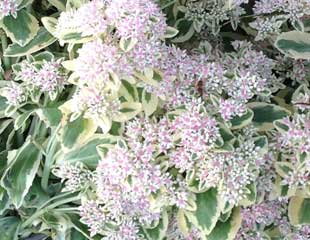
There are several Sedums with variegated foliage , this is called S.'Autumn Charm' which as the image shows, is very bright and light.
Sedum lydium
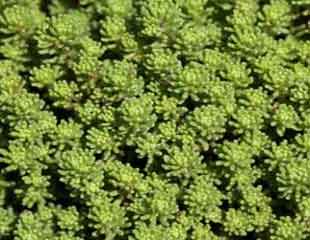
This is a low growing Sedum which forms a matt, with white flowers and good autumn colour.
Sedum rupestre
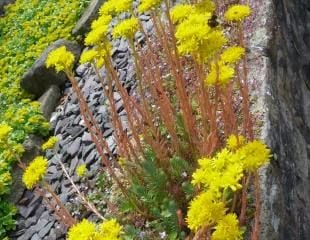
Another matt forming Sedum suitable for front of a border or rock garden it will even grow out of a wall.
One Possible problem with Sedums
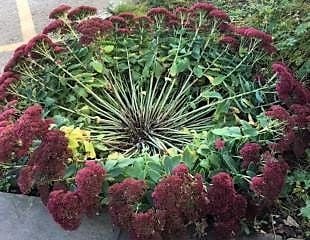
A small downside with some taller Sedums is that can be lax in habit with plants not standing upright, which can cause a bald centre.
This can also be a problem when Sedums are grown in too much shade, or rich soil. To avoid this, pinch out the plants to make them bushier or by using the Chelsea chop in late May or early June. Cut top growth by around 10cms, don't throw cuttings away because it is easy to propagate new Sedums from these clippings, see below. Nipping back stops the floppy growth and makes for a better-behaved plant.
This can also be overcome by selecting a variety of Sedum which will do better than others. I do not find this problem occurs with Ruby Glow and the RHS garden merit award varieties tend not to do this. Also, the shorter varieties have a more upright in habit. Although Sedums really are a good egg of a plant, (loved by pollinators and butterflies, low maintenance, easy to grow, flower reliably and more,) there is this one possible problem with some varieties of Sedum as shown in the image.
If you have a Sedum which does this, you can either trade it in for a newer model as many of the newer varieties do not do this, apply the Chelsea Chop earlier in the year, or stake it.
How to Propagate Sedums
Helpfully, Sedums are easy to propagate and you can have as many plants as you want for free. Looking at the image bottom left, the three rings are drawn around three generations of Sedums rooted sequentially each year. The large Sedum plant is the original plant, to the left is a cutting the following year and the small plants the next year. The cuttings quickly mature, ready to be planted out in another part of the garden.
The two smaller plants at the front were off cuts from applying "the Chelsea Chop" in late May and the cuttings were simply just pushed into the ground from where they rooted, very easy. Once rooted and established, the Sedum plants can be transferred into the border providing plenty of late colour and food for the bees and butterflies. For more information on plants attractive to bees and butterflies, check out the wildlife garden
Sedums will also root if placed in a Vase or water and produce most interesting off shoots which can be rooted up for more plants. The image below is part of a stem in water.
